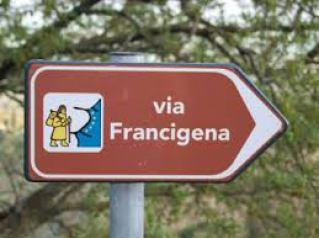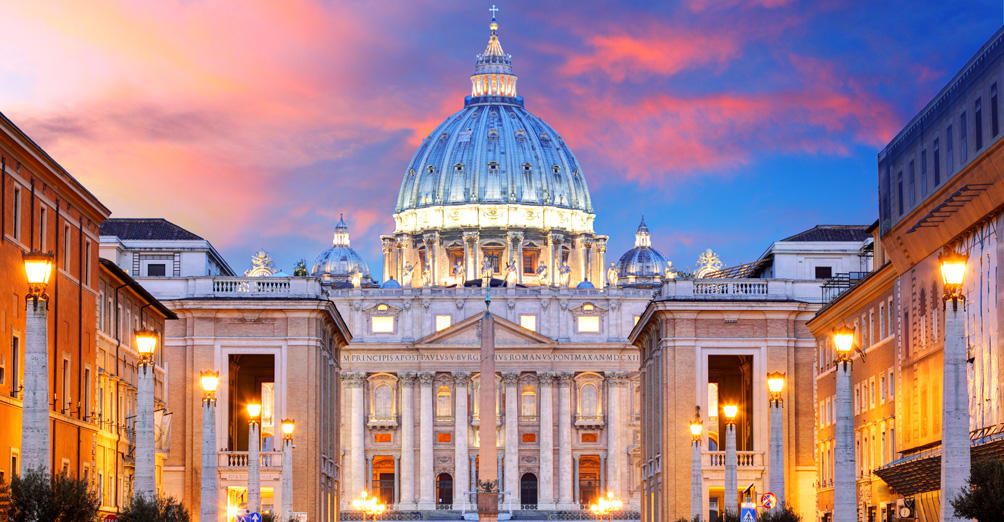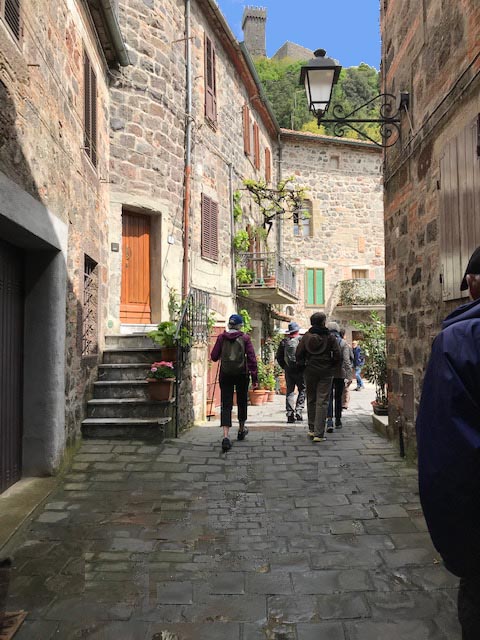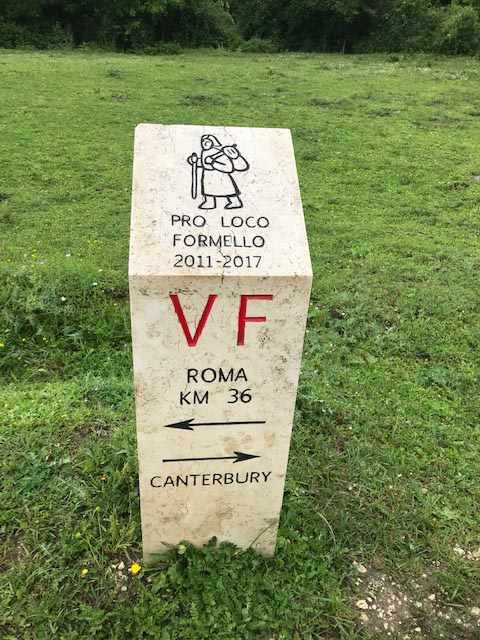WALKERS’
WORLD
Via Francigena
(The Italian Camino)
Guided Walk from Tuscany to Rome
 |
 |
 |
| Itinerary Day One: Meet in Orvieto at the Grand Hotel Italia. With direct train service running from Rome, Orvieto is easy to reach. It is a stunning town dating back to Etruscan times and definitely worth arriving early to explore. The Archaeological Museum is located in what was once a Papal Palace from the 1300’s where popes sought refuge from the intrigues of Rome. Here, and in ancient caves, one sees remnants of Etruscan life from 600BC and also from days of the Roman Empire. Marvel at the fantastically ornate Cathedral built in 1290 with its great art treasures including scenes of the Last Judgement by Luca Signorelli. But Orvieto is not just about history – its wine is some of Italy’s best and the town is known for its participation in the “Slow Food” movement which emphasizes using the best local ingredients, traditional cooking methods and leisurely dining. We meet at the hotel at 4.00 PM, have a short walk to see Orvieto then an aperitif before dinner. GRAND HOTEL ITALIA Day Two: Walk to Radicofani (Overnight again in Orvieto) 18 km (can be reduced to 11) Our private bus takes us to our starting point on the Via Francigena and from here the walk is through one of most wild and beautiful sections of the Via Francigena with Mount Amiata in the background. Radicofani is home to one of the most impressive medieval fortresses in Italy. In the days of pilgrimage, the castle was a stopover and safe haven for pilgrims and stories are told of the Italian version of Robin Hood, Ghino di Taacco, the "Gentleman Bandit". who robbed the rich but spared the poor. At the end of the walk we return by coach to Orvieto. GRAND HOTEL ITALIA Day Three: Acquapendente to Bolsena 18 km (can be reduced to 11) Today we start our walk at Acquapendente. In the middle ages a Benedictine monastery was built here and it became a stopping place for pilgrims. The town was known as the "Jerusalem of Europe" because its cathedral was said to contain fragments of stone from the Holy Sepulchre in Jerusalem. In medieval times invasions from rival towns were always a danger and we can still see the old city gates including one named for a heroine who saved the town by closing the gate just in time to keep out the enemy. Our starting point is actually a few km outside the town. The challenge walkers start here while the easy walkers continue by bus to San Lorenzo Nuovo. The longer walk passes through a territory which is rich in Etruscan archaeological finds. From San Lorenzo di Nuovo it is an easy 11 km walk to the town of Bolsena and soon the sparkling waters of Lake Bolsena come into view. Arriving in Bolsena there is a chance to visit Monaldeschi Castle and a museum dedicated to the original Etruscan settlement, the Romans and the Middle Ages. The church of Santa Cristina is also worth a visit. Or you may prefer to forget history and enjoy the lakeside cafes and gelato shops along the lakeside promenade. One of the gelato shops here won first prize in a recent Italy-wide gelato contest for their hazelnut and cinnamon flavours. But of course it is almost impossible to decide when offered four different versions of chocolate. We spend the night at the lakefront HOTEL LORIANA PARK Day Four: Bolsena to Montefiascone 18 km (can be reduced to 12) From Bolsena to Montefiascone the Via Francigena leads through lovely countryside, wooded areas and olive groves that produce some of Italy’s finest olive oil. Often there are pretty views over Lake Bolsena. Some of the walk is on what was once a Roman road and one can still see original Roman paving stones. The walled town of Montefiascone is atop a hill with views of the lovely surrounding countryside and Lake Bolsena and it has changed little since medieval times. You can visit the cathedral and admire the frescoes depicting early martyrs or you can explore the remains of the old Papal summer residence. If you sample the local wine you will no doubt hear the story of how it got its name “Est!Est!!Est!!!”. Legends says that a medieval bishop was travelling the Via Francigena and sent his valet ahead to choose lodging that would serve good wine. The valet was to mark the door with a secret code “est” (Latin for “it is”). When the valet came to Montefiascone he found the wine so good he wrote “Est! Est!! Est!!!”. Local vintners have kept that name and the town still has a reputation for its wine HOTEL URBANO V Day Five: Montefiascone to Viterbo 12 km Today’s walk is short so we can reach Viterbo with enough time and energy to explore the town. The walk is on a plain that divides Lake Bolsena from the Cimini Mountains and a highlight is the Bagnaccio thermal pools where we have a chance for a dip or at least to dabble our toes in the six steamy therapeutic pools (all different temperatures) that are the result of a natural hot spring. From the pools we travel by bus to avoid walking through suburbs of Viterbo and to give us time to explore this well preserved medieval town. Every twist and turn of the old quarter's narrow streets provides a feast for the eyes. There are several great museums, beautiful churches and pretty piazzas to enjoy but and the biggest attraction is the Papal Palace. Viterbo is called "La Citta' dei Papi" (the City of Popes) and we hear stories of popes and anti-popes, treachery and intrigue. Another highlight is San Lorenzo Cathedral. Inside the Cathedral is a plaque recording the spot where an English noble, Henry, son of the Earl of Cornwall, was attending a Papal court in Viterbo and was murdered by his cousins. Next door, the small museum has displays of Cathedral relics including a reliquary which claims to contain the chin of St. John the Baptist. But there is more to Viterbo than history and relics. The centre of the town is a treasure trove of gelaterias, cafes, piazzas and fountains. HOTEL MINI PALACE
Day Six: Rest day in VIerbo
|
Click below for details:
| Via Francigena | Itinerary |
| Cost | Frequently Asked Questions |
| Booking | Via Francigena Accommodation |
Back to Walkers World Home Page
|
|


